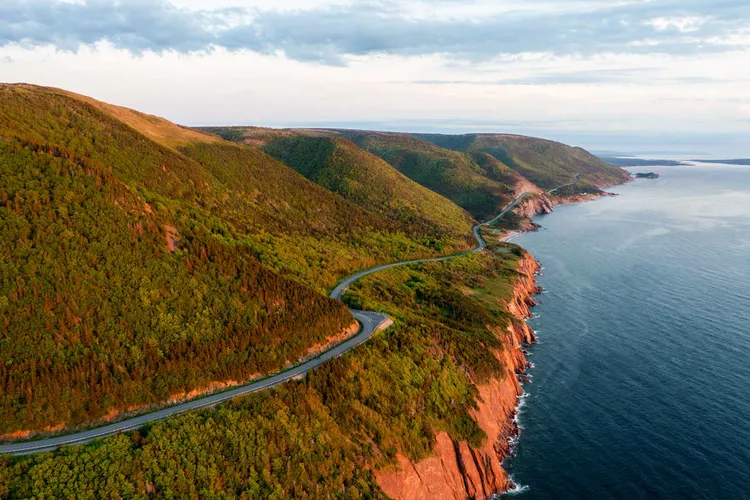Summary
Getting to Cape Breton Island is always transportive. It’s a scenic 2½-hour drive from my residence in rural Nova Scotia, and those coming from urban Halifax will experience notable transitions as the urban landscape gives way to rolling hills.
No matter your starting point, the most striking shift occurs at the end of the mile-long Canso Causeway, which connects the mainland to Cape Breton. Upon seeing windswept shores and lush forests, that’s the moment you realize you’ve truly arrived.
Explore the Cabot Trail
The classic way to experience the best of the island is through the Cabot Trail. This enchanting two-lane highway loops around the island’s north, connecting its pristine wilderness areas and historical towns. The Gaelic culture of the region, shaped by immigrants from Scotland during the 1700s, is evident everywhere—ranging from live music featuring fiddles and drums to road signs in both Gaelic and English. Notably, the Acadian areas display signs in French. Traditional and Indigenous Mi’kmaq fishermen maintain their heritage in small villages, complementing the world-class resorts that dot the landscape.
Despite being a popular retreat, Cape Breton retains a sleepy charm that Canadians cherish for a break from bustling city life. The island’s rural and remote qualities are carefully preserved in offerings from locals and new arrivals, including quaint cafés, B&Bs, boat tours, and breweries. Each visit reveals new surprises, especially in the fall when the summer crowds have dissipated.
Friday Adventures
During my latest visit to Cape Breton Island in October 2021, my first stop was Big Spruce Brewing, the province’s first organic craft brewery. Established in 2009 by Jeremy and Melanie White, who bought a dilapidated farm near Bras d’Or Lake, the brewery has become famous for its locally brewed beers. I tasted their Kitchen Party Pale Ale, which paired delightfully with the regional pub specialty, deep-fried pepperoni.
Continuing my journey northwest along the Cabot Trail, I took Route 19 to Inverness, a historical coal-mining village revitalized by the opening of the Cabot Links Golf Resort in 2011. My destination was Inverness Beach, renowned for its abundance of sea glass, which I eagerly collected as souvenirs.
Overlooking this splendid beach are luxurious private villas at Cabot Cape Breton, designed by acclaimed Halifax architect Omar Gandhi. Notably, this golf resort showcases Cabot Cliffs, the top-rated golf course in Canada, offering perhaps one of the most spectacular accommodations on the island. Across the street, I enjoyed the relaxed atmosphere at the brewpub of Route 19 Brewing, where I savored the most generous lobster roll I had ever encountered.

Saturday Exploration
Traveling to Chéticamp, the Acadian pride becomes increasingly evident with historical flags frequently adorning buildings and colorful coastal homes. My destination: the Gypsum Mine, a stunning flooded quarry encircled by spruces, birches, and firs. A dip in the lake is refreshing, while the steep climb along the quarry’s edge rewards you with breathtaking water views.
While in Chéticamp, I stopped by the local favorite, Mr. Chicken for chicken poutine, but my heart was set on dining at L’abri, a restaurant that had been fully booked during my previous visit. Owned by Basil Doucet and Jaron Felix, L’abri riffs on Cape Breton cuisine, offering dishes like Cajun haddock cakes paired with soft French music filling the air.
This delicious meal fueled my next adventure: hiking the Skyline Trail, a five-mile loop through diverse terrain leading to a majestic headland boardwalk. During the hike, I finally spotted a magnificent moose grazing peacefully among the shrubs.
For dinner, I chose the Rusty Anchor Restaurant in Pleasant Bay, famous for its inviting seafood and friendly service. I relished Northern Emerald oysters alongside a succulent bacon cheeseburger. Later, I returned to a spacious geodesic dome available through True North Destinations, where I enjoyed a relaxing soak in the hot tub, gazing at the tumultuous Atlantic.

Sunday Activities
From Ingonish Beach, I embarked on a whale-watching tour with Keltic Express Zodiac Adventures. I hoped to spot Minke or the occasional humpback whale; however, despite Captain Kinnon MacKinnon’s diligent efforts, I saw neither. Instead, I was mesmerized by three enormous sunfish that graced the water’s surface. Ingonish continues to be one of the Cabot Trail’s must-visit stops, featuring stylish boutiques along its scenic route.
At Groovy Goat Farm & Soap Company, I enjoyed the delightful company of bunnies and baby goats. I also visited Leather Works by Jolene, where I purchased a buttery-soft, sunshine-yellow purse that perfectly matched the island’s colors.
For lunch, I relished a snow-crab sandwich at Salty Rose’s & the Periwinkle Café, an innovative gallery-bakery owned by cousins Caitlyn Purcell and Sarabeth Drover. Their menu features decadent egg sandwiches and artfully crafted granola accompanied by delicate flowers, all set against an artistic backdrop. After ensuring my accommodation for the night in one of the café’s vintage-chic rooms adorned with 1970s-inspired wallpaper, I took a leisurely stroll along Ingonish Beach, collecting thoughts while admiring the view of the historic Keltic Lodge perched on the cliffs, where I later enjoyed a Dark & Stormy cocktail in the elegant Highland Sitting Room.
Monday Reflections
On my final day, I ventured to Cape Smokey Provincial Park for a final glimpse of the captivating highlands before my journey home. Before leaving, I stopped by the Wreck Cove General Store to savor one last lobster roll, touted as the best on the island according to locals. Co-owner Jenn Partland attributes its deliciousness to a trusted 40-year-old recipe: a simple mixture of knuckle and claw meat, Miracle Whip, salt, and pepper.
As I finished my lobster roll, a deep sense of appreciation washed over me. There’s something profoundly satisfying about places that embrace simplicity and authenticity. Cape Breton excels at this, truly embodying the essence of natural beauty and culture.
A version of this story first appeared in the October 2021 issue of GoTravelDaily under the headline A Natural Course.





